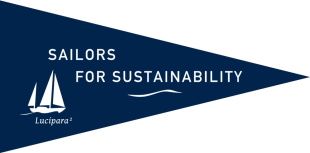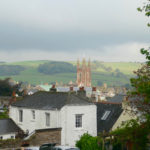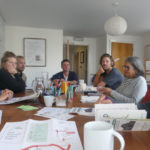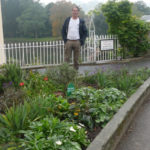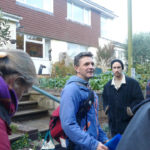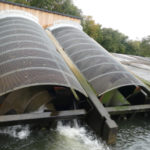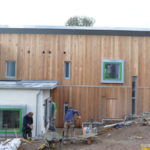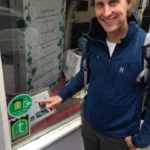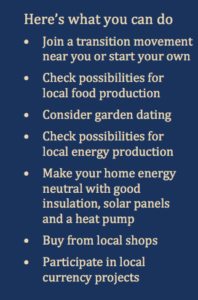Transition Town Totnes (GBR)
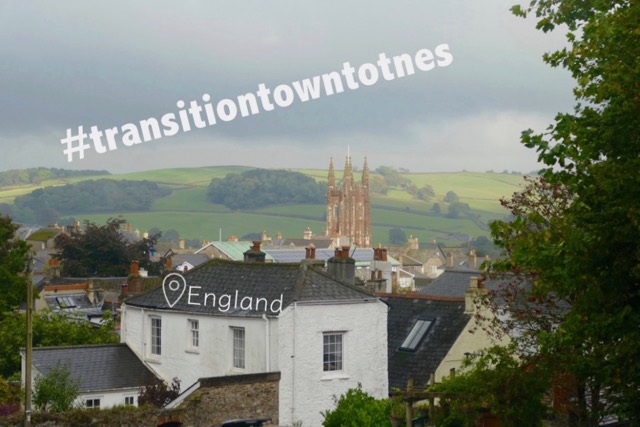
In Totnes, home of the Transition Town movement, we learn how a focus on local food, renewable energy, energy neutral living, and the local economy makes a town more resilient and sustainable.
Contributes to achieving the following UN Sustainable Development Goals:
The Caledonian Canal takes us from northern to southern Scotland via the magnificent Loch Ness. A week of calm weather in the Canal is followed by autumn depressions, so we seek shelter in the lee of the Hebrides. When an easterly wind finally arrives, we take our chance and sail southward for three consecutive days and nights. We pass Land’s End, the imposing southernmost tip of “mainland” Great Britain. From here we head towards Penzance in Cornwall, where we can take a train to Totnes. In this town in Devon, the transition to a sustainable future is led from the bottom-up.
For our previous sustainable solution we were in the Scottish “Ecovillage Findhorn”. That community is entirely committed to a sustainable lifestyle. But what do you do if you live in an ordinary village and want to do something about climate change or fossil fuel dependency? Rob Hopkins has found a solution. He wrote the “The Transition Handbook” on the transition to a sustainable, oil-independent and more resilient community. He brings his theories into practice in his hometown Totnes. We’re curious to check it out.
Getting to Know Each Other
Rob is not in town, but one of his closest colleagues Hal Gillmore receives us wholeheartedly. We can even stay in his garden house. We meet other visitors who are also eager to learn how the transition is working in practice. “In Totnes, we coordinate different projects on local food, renewable energy, energy neutral living and the local economy,” says Hal. “We facilitate these projects, but the residents are doing it themselves.”
“It may sound odd, but one of the first things we organized was a program to get to know each other as neighborhood residents. We learned that this was a necessary first step for projects to succeed. People who know each other and want to work together are an essential ingredient for success,” he continues. How do these projects work? Hal explains it during a tour of the village.
Food Sharing and Garden Dating
Our first stop is at a green-strip along the public road. On a piece of land where the municipality used to maintain ornamental plants, enthusiastic neighborhood residents now grow edible plants and herbs. A homemade sign indicates that it is a “public garden” and invites everyone to pick what they need. “At this point it is about raising awareness, rather than trying to feed the entire community,” Hal explains. “This shows that public space can be used for food supply.”
A little later we stand at a front garden of a terraced house. Leeks, onions, carrots, herbs and fruit trees are grown. According to Hal, it represents quite a cultural change. “In the past, this was unthinkable to grow vegetalbes in the front yard, you would be laughed at by your neighbors. Now it’s getting normal.”
It sounds great, but gardening takes a lot of time and we wonder if it is achievable for young families with working parents. “We set up a project called garden dating. People with a garden but without time are connected to people without a garden but with time. It reinforces the community sense in the neighborhood and disseminates knowledge about growing food. The yield is divided among each other. It is one of our most successful projects,” Hal explains proudly.
As we continue the tour, Hal points out another advantage of growing your own food. “There is much less food waste. If you need something, you take the desired amount directly out of the garden. People become better aware of food waste if they put in the effort of growing it themselves. And it is as fresh as possible.”
Local food production helps the community to become less dependent on oil, one of the objectives of the Transition Town movement. Many foods are grown using synthetic fertilizers, pesticides and herbicides. These are not only unhealthy for soil, humans and animals, but are also made of finite fossil raw materials. In addition, long-distance transport requires a lot of fuel. Where food is locally grown according to biological principles, no chemicals, transport fuels and packaging are required. And that’s surely more sustainable.
Renewable Energy, Locally Generated
Our tour continues. At the edge of the village on the river Dart we admire the “Archimedes screw”. Two large, screw-shaped waterwheels slowly rotate as river water flows through them. Hydropower was an obvious choice to renew the local energy supply, given the town’s location on the river Dart. The initiave for the Archmides screw came from a number of local people who formed a project group to modernize an old waterwheel. They have also thought of including a fish ladder, which makes it easy for fish to pass.
The Archimedes screw generates over ten percent of the power consumption in Totnes. In addition, the inhabitants of the town use solar panels and wind turbines. By utilizing local opportunities to generate renewable energy, they reduce the dependency on energy generated elsewhere. And they also reduce the CO2 emissions of the municipality, lowering their contribution to climate disruption.
Energy-Neutral Living
Back in town we visit different ecohomes. They are open to the public this weekend to allow neighbours and visitors a peak inside and learn what makes these houses “eco”. The houses vary in age from newly built to Victorian, and from detached to terraced. Good insulation is a common feature, and many homes generate their own energy, for example with solar panels. Transition Town Totnes stimulates this by facilitating the joint purchase of the solar panels. There is even one house with a “powerwall” to store excess solar energy. We also see biomass boilers, ground source heat pumps, solar thermal water heating, and a toilet that uses rainwater to flush.
In a newly built home, a local contractor explains what they have done to make the house energy neutral. The builder, Terra Perma, is specialized in ecological building. “We used mainly timber and other natural materials, such as lime. The walls and roof are very well insulated, among others with wood fibre boards. The house is located in such a way that there are many windows and a large roof area facing south”. How very smart. This allows the sun to warm the interior during the day, also known as passive solar heating. The floor absorbs the heat, which is distributed throughout the house. The house can be heated with one heat-cold pump, but we learn that the residents have chosen for a wood stove for budget reasons.
Stimulating the Local Economy
All these local activities support the local economy. There is even a local currency: the Totnes Pound. This currency is as valuable as the pound sterling and is accepted by the participating stores in town. Curious about the details, we learn it works more like a voucher-scheme than official money, but still, it keeps money in the community and thus encourages local jobs.
The local approach seems to work. When we stroll through High Street, we see a large number of specialty stores. There is a shop selling organic regional products and there are some fresh bakeries, teahouses and restaurants. No locations are vacant and chain stores are notably absent. The emphasis on the region is probably the most outspoken in the “Not Made in China” store, which carries a whole range of regional products.
Transition Network
Although Hal mentiones more than once that there is still a lot more to be done, the success Transition Town Totnes has not gone unnoticed. The initiative has been followed in more than 1,100 villages and cities in 43 countries around the world. To help other towns “transition”, a separate organization called “Transition Network” has been established. This network aims to exchange knowledge and experiences.
Are you curious whether there is already such a transition initiative in your town or do you want to start it yourself? Check out the Transition Network website and join the movement!
Related Sustainable Solutions

Enviroschools (NZL)
What does it take to integrate sustainability in education? New Zealand’s Enviroschools are leading the way.

Buy Local (PYF)
In Tahiti we discover markets with fresh fruit and vegetables from the island. We learn that buying local has various benefits for the community.

Self-Sufficient Living (PYF)
On the island of Taravai, we meet a self-sufficient family. Their lifestyle is not only more resilient, but also provides sustainability benefits.

Community-Based Tourism (PER)
Community-based tourism, with slow travel and homestays at its core, makes for an authentic and more sustainable travel experience.

Sustainable Schools (URY)
The buildings and teachings at these schools are textbook examples of sustainability.

Ecovillage Findhorn (GBR)
Spirituality plays a big part at Findhorn Ecovillage, which is based on love for nature and each other.
